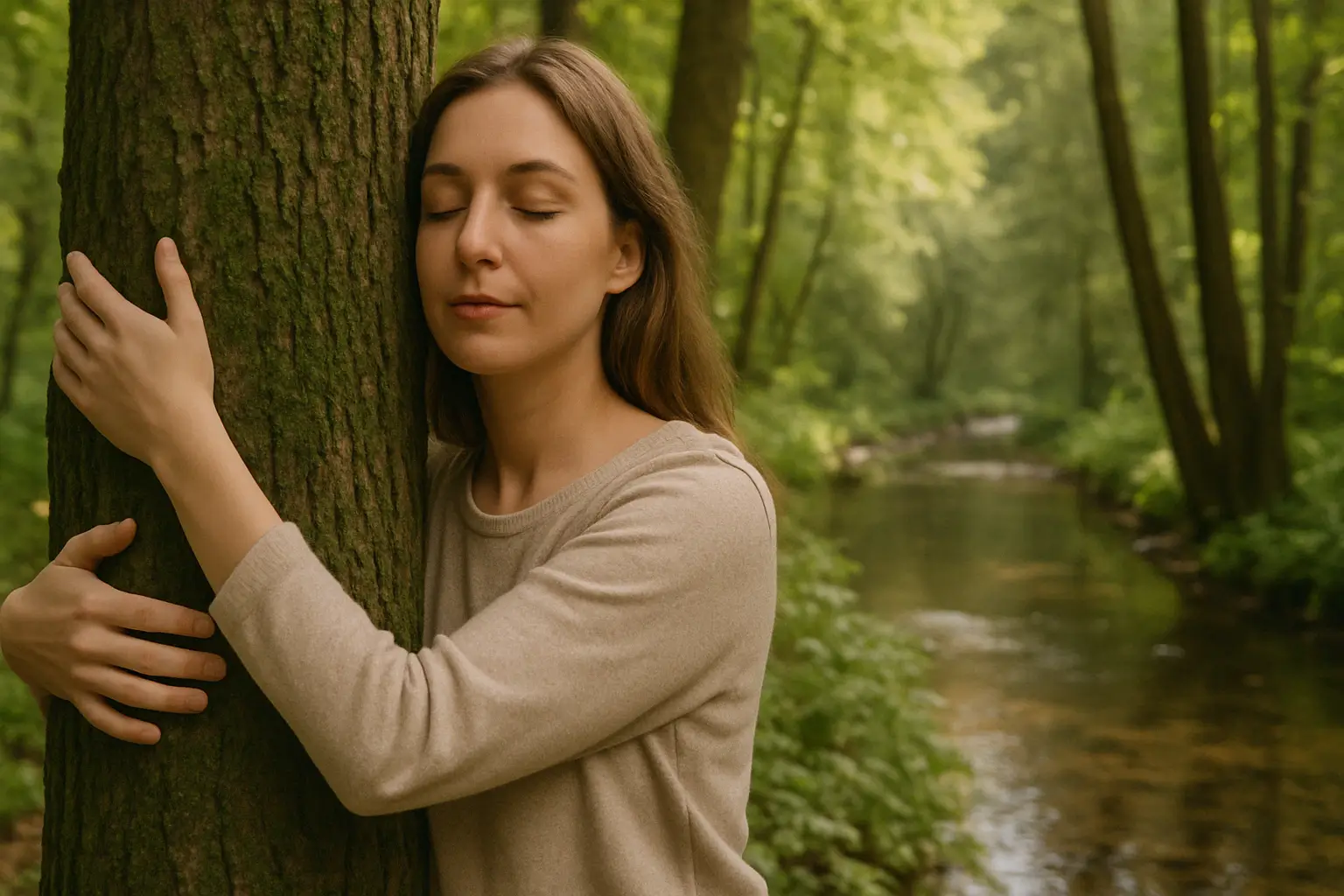Did you know that spending time in nature can reduce stress hormones and improve your mental well-being? This is not just a pleasant notion, but a growing body of research that highlights the profound impact of natural environments on our brain function and mental health. As humans, we have an intrinsic connection to nature that has existed throughout our evolutionary history.
However, modern lifestyles have created a nature deficit that contributes to rising stress levels and mental health challenges. Ecopsychology emerges as a transformative field that harnesses the power of nature to improve our mental well-being. By exploring the fundamental connection between humans and nature, we can uncover accessible, effective approaches for rewiring our neural pathways to promote calm and clarity.
Key Takeaways
- Nature exposure positively affects brain function and mental health.
- Modern lifestyles contribute to a nature deficit, increasing stress and mental health challenges.
- Ecopsychology offers nature-based approaches for improving mental well-being.
- Spending time in nature can reduce stress hormones.
- Nature has a profound impact on our brain function and mental health.
The Science Behind Nature’s Effect on the Brain
The profound impact of nature on our mental well-being has sparked intense scientific interest, leading to a deeper understanding of its effects on the brain. Research has shown that exposure to natural environments can have a positive impact on both mental health and cognitive function.

Understanding the Stress Response
When we encounter stress, our body’s “fight or flight” response is triggered, releasing hormones like cortisol and adrenaline. This stress response is meant to be a temporary reaction, but chronic stress can have negative effects on our mental and physical health. Understanding how the stress response works is crucial to appreciating the benefits of nature therapy.
Chronic stress can lead to anxiety, depression, and other mental health issues if not managed properly. The stress response is closely linked to the brain’s emotional processing centers, which can be influenced by our environment.
How Natural Environments Affect Neural Pathways
Natural environments have been shown to affect neural pathways in the brain, promoting relaxation and reducing stress. Studies have found that exposure to nature can decrease activity in the brain’s stress centers, leading to a sense of calm and well-being.
This is supported by a study that found that individuals who spent time in natural environments exhibited reduced symptoms of anxiety and depression compared to those who did not.
The Biophilia Hypothesis: Our Innate Connection to Nature
The biophilia hypothesis, proposed by E.O. Wilson, suggests that humans have an innate affinity for nature and living systems. This hypothesis is based on the idea that humans have evolved in natural environments, making us genetically programmed to respond positively to certain natural features.
The biophilia hypothesis helps explain why therapy based on nature exposure can be effective in promoting mental health benefits across diverse populations. By leveraging our innate connection to nature, we can promote healing and well-being.
The Foundations of Nature-Based Psychology
The foundations of nature-based psychology are rooted in several key theories that explain how our interactions with the natural world impact our mental health and well-being. These theories provide a comprehensive understanding of the psychological benefits derived from engaging with nature.
Attention Restoration Theory (ART)
Attention Restoration Theory (ART) posits that exposure to natural environments can restore our ability to focus and concentrate. According to ART, modern life often demands significant attentional effort, leading to mental fatigue. Natural environments, with their inherent fascinating stimuli, allow our minds to rest and recover, thereby improving cognitive functioning.
Psycho-Evolution Theory (PET)
Psycho-Evolution Theory (PET) suggests that humans have an innate tendency to respond positively to natural environments because they have evolved to be restorative. This theory is based on the idea that our ancestors’ survival depended on their ability to navigate and appreciate natural landscapes. As a result, humans are predisposed to find natural settings restorative and satisfying.
Topophilia: Developing a Love for Natural Places
The concept of topophilia expands on the biophilia hypothesis by suggesting that humans can develop a deep affection for specific places through their experiences. Topophilia, or the “love for places,” is formed through meaningful interactions with the environment. This emotional connection to natural places can significantly contribute to our mental health and overall satisfaction with life.
Research has shown that developing topophilia can have numerous psychological benefits. For instance, people who have strong emotional connections to natural places tend to have better mental health outcomes and a greater sense of well-being. The process of forming these connections involves creating lasting memories and experiences in nature, which can be fostered through repeated visits to favorite natural locations.
| Theory | Key Concept | Psychological Benefit |
|---|---|---|
| Attention Restoration Theory (ART) | Restoration of cognitive resources | Improved focus and concentration |
| Psycho-Evolution Theory (PET) | Innate response to natural environments | Restoration and satisfaction |
| Topophilia | Emotional connection to places | Better mental health outcomes |

By understanding and applying these theories, individuals can cultivate a deeper appreciation for nature and improve their mental well-being. The connection between humans and their natural environment is complex and multifaceted, and exploring this relationship through the lens of nature-based psychology can provide valuable insights into enhancing our overall quality of life.
How Modern Life Disconnects Us from Nature
As urbanization and technology advance, our connection to nature is becoming increasingly tenuous. This disconnection is not merely a matter of personal preference but has significant implications for our mental health and overall well-being.
The Impact of Urban Environments on Mental Health
Urban environments, characterized by desolate buildings and lack of green spaces, have been linked to higher levels of mental fatigue, aggression, and violence. Research by Kuo & Sullivan indicates that individuals living in such environments experience more mental health issues compared to those residing in rural areas with access to natural environments. A study on the effects of urban living found that residents without a natural environment tend to be lazier and regard problems more seriously than those with access to nature.
| Environment | Mental Fatigue | Aggression/Violence |
|---|---|---|
| Urban (desolate) | Higher | Higher |
| Rural (natural) | Lower | Lower |
Screen Time vs. Green Time
The dramatic increase in screen time, especially among younger generations, corresponds with a decrease in nature exposure. Studies have shown that excessive screen time affects attention spans, stress levels, and overall mental health. In contrast, spending time in nature, or “green time,” has been shown to reduce mental fatigue, improve efficiency, and enhance problem-solving abilities, leading to greater satisfaction in daily life.
For instance, research has highlighted the concept of “nature-deficit disorder” and its potential consequences for development and well-being. Constant digital connectivity creates a state of continuous partial attention that prevents mental restoration. Furthermore, screen time before bed affects sleep quality compared to evening nature exposure.

To mitigate these effects, it’s essential to balance necessary technology use with restorative “green time” in natural settings. By being mindful of our technology use and ensuring regular nature exposure, we can optimize our mental health in the digital age.
The Six-Stage Process of Nature-Based Healing
Nature-based therapy unfolds through six distinct stages, each contributing to a profound healing experience. This structured process guides individuals toward mental clarity and emotional balance, fostering personal growth.
Stage 1: Stimulation – Initial Positive Emotional Change
The journey begins with stimulation, where natural environments evoke positive emotional responses. This initial stage is characterized by feelings of awe, wonder, and curiosity, laying the groundwork for further healing through nature therapy.
Stage 2: Acceptance – Feeling Welcomed by Nature
As individuals progress, they experience acceptance, feeling a deep sense of connection and belonging in natural settings. This stage fosters a sense of being part of a larger ecosystem, promoting emotional acceptance and overall satisfaction.
Stage 3: Purification – Releasing Negative Emotions
Purification follows, where the natural environment facilitates the release of negative emotions and stress. This cathartic process is essential for emotional cleansing and renewal, contributing to improved mental health.
Stage 4: Insight – Gaining New Perspectives
The insight stage brings about a deeper understanding of oneself and one’s place in the world. Nature experiences provide new perspectives, helping individuals reframe challenges and opportunities, leading to positive change.
Stage 5: Recharging – Restoring Mental Energy
Recharging is a critical stage where individuals restore their mental energy. The tranquility of natural environments helps alleviate mental fatigue, promoting rejuvenation and supporting the therapy process.
Stage 6: Change – Transforming Thoughts and Behaviors
The final stage, change, is where insights and restored energy translate into concrete life changes. This transformation stage is characterized by shifts in priorities, values, and daily behaviors, leading to improved mental health and overall well-being.
The six-stage process of nature-based healing is not just a therapeutic approach but a journey of personal transformation. By understanding and embracing these stages, individuals can harness the full potential of nature therapy.
| Stage | Description | Key Outcomes |
|---|---|---|
| Stimulation | Initial positive emotional response to nature | Awe, wonder, curiosity |
| Acceptance | Feeling connected and welcomed by nature | Emotional acceptance, sense of belonging |
| Purification | Release of negative emotions and stress | Emotional cleansing, renewal |
| Insight | Gaining new perspectives and understanding | New perspectives, reframed challenges |
| Recharging | Restoring mental energy | Mental rejuvenation, reduced fatigue |
| Change | Transforming thoughts and behaviors | Improved mental health, changed priorities |
The transformation stage often includes increased environmental awareness and conservation behaviors. Techniques such as mindfulness and journaling can support the integration of nature-inspired changes into everyday life, enhancing the overall therapy experience.
By exploring the final stage of nature-based healing, it becomes clear that the journey through the six stages is not just about personal growth but also about developing a deeper connection with the natural world, leading to lasting change.
Types of Nature Therapy Programs
Nature therapy programs offer diverse approaches to mental health treatment, leveraging the healing power of the natural world. These programs vary in their methods and settings, but all share the goal of improving mental well-being through interaction with nature.

Adventure Therapy
Adventure therapy involves using outdoor activities like hiking, camping, or rock climbing to promote personal growth and healing. This type of therapy is particularly effective for building trust and confidence within groups.
Animal-Assisted Interventions
Animal-assisted interventions involve the use of animals, typically dogs, to support therapy sessions. These interventions can help individuals open up and engage more deeply in the therapeutic process.
Nature-Based Arts and Crafts
Nature-based arts and crafts therapy encourages individuals to express themselves creatively using natural materials. This can be a powerful way to process emotions and develop new coping strategies.
Conservation Activities
Conservation activities, such as tree planting or habitat restoration, provide a sense of purpose and fulfillment. They can also foster a deeper connection to the natural world.
Green Exercise
Green exercise refers to physical activity undertaken in natural environments. This can range from walking and jogging to more structured exercise programs, all aimed at improving physical and mental health.
Therapeutic Horticulture and Farming
Therapeutic horticulture and farming involve growing plants and participating in farming activities as a form of therapy. These activities can promote relaxation, improve mood, and provide a sense of accomplishment.
Wilderness Therapy
Wilderness therapy is an immersive form of therapy that involves living in and exploring wilderness areas. It’s particularly effective for adolescents and young adults, promoting self-reliance, teamwork, and personal growth.
Wilderness therapy programs, such as those involving group activities in remote natural settings, have been shown to be effective in treating a range of mental health issues. By removing participants from their usual environments and distractions, these programs facilitate deeper psychological shifts and personal transformation.
Starting Your Nature-Based Healing Journey
To harness the therapeutic potential of nature, it’s essential to start with a clear understanding of your current connection to the natural world. This self-awareness lays the foundation for a personalized and effective nature-based healing practice.
Assessing Your Current Nature Connection
Begin by reflecting on your current relationship with nature. Consider how often you spend time outdoors, the types of natural environments you enjoy, and the activities that make you feel most connected to the earth. This assessment can help identify areas for improvement and guide your intentions for deepening your nature connection.
You can use the following table to assess your current nature connection:
| Aspect | Current State | Desired State |
|---|---|---|
| Frequency of outdoor activities | ||
| Preferred natural environments | ||
| Nature-based activities enjoyed |
Setting Intentions for Your Practice
Setting clear intentions is crucial for a meaningful nature-based healing practice. Identify specific mental health challenges you want to address, such as stress, anxiety, or depression. Clarify your personal goals, whether it’s to enhance your mood, improve focus, or simply find more calm in your daily life.
Consider the following when setting your intentions:
- What are your primary goals for engaging in nature-based healing?
- How do you envision your ideal nature experience?
- What rituals or practices can you incorporate to support your intentions?
Writing down your intentions and revisiting them regularly can enhance your practice and lead to greater satisfaction. By balancing structure and spontaneity, you can create a fulfilling nature connection experience that supports your overall well-being and therapy goals.
Finding Your Green Space: Accessible Nature for Everyone
The therapeutic benefits of nature are within reach, regardless of whether you live in an urban, suburban, or rural setting. Research has shown that frequent trips to parks or forests near one’s home are more effective for health promotion than occasional trips to distant mountains. This finding underscores the importance of accessible green spaces in our daily lives.
Understanding the opportunities available in different environments can help individuals maximize their nature experience. Whether you reside in a bustling city, a suburban neighborhood, or a rural area, there are unique ways to connect with nature and reap its benefits.
Urban Nature Opportunities
Urban areas offer a variety of nature experiences, from parks and gardens to waterfronts and green roofs. These spaces provide residents with opportunities to engage with nature despite the urban landscape. For example, community gardens not only offer green space but also foster community engagement and a sense of accomplishment.
Suburban Green Spaces
Suburban areas typically have more expansive green spaces than urban centers, including larger parks and nature reserves. These areas allow for longer, more immersive nature experiences, such as hiking and birdwatching, which can be particularly beneficial for mental health.
Rural Nature Immersion
Rural settings provide extensive opportunities for nature immersion, with vast landscapes, forests, and wildlife. The abundance of natural areas in rural settings allows residents to develop a deep connection with their environment. By exploring public lands, preserves, and wilderness areas, individuals can experience the full therapeutic potential of nature.
Rural residents can benefit from seasonal changes, which offer varied opportunities for nature connection throughout the year. Overcoming “nature blindness” to familiar surroundings can help individuals rediscover the therapeutic value of their local environment. Moreover, rural communities are increasingly developing nature-based programs to address mental health challenges, further enhancing the accessibility of nature’s benefits.
In conclusion, finding and utilizing green spaces is crucial for mental well-being, and the opportunities are diverse across different environments. By understanding and leveraging these opportunities, individuals can improve their mental health and overall satisfaction with life.
Daily Nature Practices for Mental Clarity
Daily nature practices offer a powerful tool for achieving mental clarity and reducing stress. By incorporating nature into daily routines, individuals can experience significant improvements in mental clarity and overall satisfaction with life. The key is to establish consistent practices that foster a deeper connection with the natural world.
Morning Nature Rituals
Starting the day with a nature ritual can set a positive tone for the hours ahead. This could involve a short walk outside, some deep breathing exercises on a balcony or patio, or simply spending a few moments gazing out the window at the natural world. Such rituals can help increase time spent in nature, enhancing the overall experience and promoting a sense of calm.
Midday Green Breaks
Taking short breaks during the day to connect with nature can significantly improve mental clarity and productivity. Even a brief walk outside or a few moments spent in a nearby park can be beneficial. These midday green breaks can help reduce stress and improve focus, making it easier to tackle complex tasks.
Evening Wind-Down in Nature
As the day comes to a close, spending time in nature can be a gentle and effective way to wind down. This might involve taking a relaxing walk, practicing some light stretching or yoga outdoors, or simply sitting in a natural setting and observing the surroundings. Such practices can enhance the quality of contact with nature, promoting a deeper sense of relaxation and preparing the body for rest.
Seasonal Adaptations
Adapting nature practices to the changing seasons can keep the experience fresh and engaging. For example, spring might be a time for renewal and growth, with activities focused on planting or observing the blossoming of flowers. Summer could involve more water-based activities or simply enjoying the warmth and long days. Autumn might bring a focus on harvesting or reflecting on the year’s progress, while winter could be a time for cozying up in natural settings or observing the serene beauty of snow-covered landscapes. By adapting practices to the seasons, individuals can maintain a consistent connection with nature throughout the year, enhancing overall satisfaction with their nature practice.
By incorporating these daily nature practices into one’s routine, individuals can cultivate a deeper connection with the natural world, leading to improved mental clarity and a greater sense of well-being.
Forest Bathing: The Japanese Art of Shinrin-Yoku

By embracing the concept of Shinrin-Yoku, individuals can tap into the therapeutic potential of nature and enhance their overall health experience. This traditional Japanese practice involves immersing oneself in the natural environment to promote physical and mental well-being. Research has shown that spending time in forests can have a positive impact on health, reducing stress and promoting relaxation.
The Five Senses Approach
A key aspect of forest bathing is the engagement of all five senses. By slowing down and intentionally noticing the sights, sounds, smells, tastes, and textures around them, individuals can deepen their connection with nature. This mindful approach encourages a sense of presence and calm, allowing participants to let go of worries and distractions.
Studies have demonstrated that the sensory experience of being in a forest environment can lower cortisol levels, blood pressure, and heart rate, while also boosting the immune system by increasing the activity of natural killer cells. By incorporating all senses, forest bathing provides a holistic experience that nurtures both body and mind.
Guided vs. Self-Directed Forest Bathing
There are two primary ways to experience forest bathing: guided and self-directed. Guided forest therapy walks are led by certified guides who provide structure and deepen the experience through specific exercises and prompts. These guides can help participants develop techniques that enhance their future self-directed practice.
On the other hand, self-directed forest bathing allows individuals to explore and connect with nature at their own pace. With the right resources and guidance, individuals can create their own forest bathing invitations and sequences for personal practice, tailoring the experience to their needs and preferences.
Whether guided or self-directed, the practice of Shinrin-Yoku offers a powerful tool for reducing stress and improving overall health. By incorporating this practice into one’s lifestyle, individuals can cultivate a deeper appreciation for nature and enhance their overall experience of well-being.
Nature-Based Mindfulness Techniques
Engaging with nature through mindfulness practices is a transformative approach to improving mental health and awareness. By integrating mindfulness techniques with the natural world, individuals can cultivate a deeper sense of connection and tranquility.
Nature-based mindfulness involves paying attention to the present moment in a natural setting, fostering a sense of calm and clarity. This practice can be particularly effective in reducing stress and improving attention.
Grounding Exercises
Grounding exercises in natural settings help individuals focus on the present moment by engaging their senses. Techniques include walking barefoot on the earth, observing the sensation of the sun’s warmth, or listening to the sounds of nature. These exercises can significantly enhance one’s sense of connection to the natural world and improve mental health.
Nature Meditation
Nature meditation practices involve using natural environments as a focal point for meditation. This can include sitting by a body of water, observing the patterns of clouds, or simply being among trees. The goal is to cultivate mindfulness and a deeper appreciation for nature, allowing for a greater sense of peace and clarity over time.
Mindful Observation
Mindful observation of natural elements encourages individuals to deeply engage with their surroundings. By focusing on the details of plants, animals, water, and other natural phenomena, one can develop greater awareness and attention. Regular practice can change one’s perception and enhance appreciation for the natural world.
Documenting observations through journaling, sketching, or photography can further deepen the experience, providing a reflective record of one’s journey and insights gained.
Therapeutic Gardening for Mental Health

The practice of therapeutic gardening is gaining recognition for its positive impact on mental health. By combining physical activity with the therapeutic benefits of being in nature, individuals can experience significant improvements in their overall well-being. Therapeutic gardening involves growing plants, either for food or ornamentation, and has been shown to have a positive effect on mental health.
This form of therapy is not limited to professional settings; it can be practiced by anyone with access to a garden or even just a few pots on a balcony. The act of nurturing plants and watching them grow can provide a sense of satisfaction and fulfillment. Moreover, involving family members in gardening activities can enhance its benefits, making it a valuable activity for all ages.
Container Gardening for Limited Spaces
For those with limited space, container gardening offers an accessible way to engage in therapeutic gardening. By using pots and containers, individuals can grow a variety of plants on balconies, patios, or even indoors. This method allows for flexibility and can be adapted to suit different needs and spaces.
Community Garden Participation
Participating in community gardens is another way to experience the benefits of therapeutic gardening. Community gardens provide not only a space to grow plants but also an opportunity to connect with others who share similar interests. This social aspect can enhance the therapeutic effects of gardening by providing a sense of community and support.
The Healing Power of Growing Food
Growing one’s own food can have a particularly profound impact on mental health. The process of cultivating and harvesting edible plants connects individuals to basic life processes and ancestral knowledge. Research has shown that growing food can affect self-efficacy, resilience, and sense of security positively. Moreover, the harvest and sharing of homegrown food can create meaningful rituals and celebrations, further enhancing its therapeutic benefits.
Nature-Based Activities for Specific Mental Health Challenges
Nature-based activities offer a promising approach to addressing various mental health challenges by leveraging the therapeutic potential of natural environments. Research has shown that exposure to nature can have a positive impact on both physiological and psychological well-being.
Anxiety Reduction Practices
Activities such as mindfulness in nature, walking in forests, and simply spending time in green spaces have been shown to reduce anxiety levels. These practices help calm the mind and reduce stress.
Depression-Lifting Nature Experiences
Nature experiences like gardening, outdoor activities, and exposure to natural light can help alleviate symptoms of depression. These activities promote a sense of accomplishment and improve mood.
Attention-Enhancing Outdoor Activities
Outdoor activities such as hiking, bird watching, and outdoor games can improve attention and cognitive functioning. These activities require engagement and can help improve focus.
Stress-Relieving Natural Environments
Natural environments like beaches, mountains, and forests have been identified as effective in reducing stress levels. The calming effects of these environments can help mitigate the impact of stress.
To maximize the benefits, individuals can identify personally restorative environments and create stress-relieving micro-environments in their daily lives. Developing a personal “stress relief map” can also be beneficial.
Building a Consistent Nature Connection Practice
Building a lasting relationship with nature involves overcoming various barriers and integrating it into daily life. To achieve this, one must consider several factors that influence the consistency of nature-based practices.
Overcoming Weather and Seasonal Barriers
One of the primary challenges to maintaining a nature connection practice is dealing with varying weather conditions and seasonal changes. Adapting to these changes is crucial for consistency. For instance, during harsh weather, indoor plants or virtual nature experiences can serve as alternatives. In addition, understanding and respecting the unique qualities of each season can help in planning appropriate nature activities.
For example, winter can be a good time for indoor gardening or nature journaling, while spring and summer offer opportunities for outdoor activities like hiking or bird watching. By embracing the characteristics of each season, individuals can maintain their connection with nature throughout the year.
Integrating Nature into Your Daily Routine
To make nature a consistent part of life, it’s essential to integrate it into daily routines. This can be achieved by starting small, such as taking short walks during breaks or keeping plants in the workspace. Even simple actions like observing the sky or listening to natural sounds can be beneficial.
Creating a schedule that includes nature activities can also help. For instance, dedicating a specific time each day for nature connection, such as early morning or before bed, can make it a habit. Moreover, involving family members or friends in these activities can enhance commitment and make the experience more enjoyable.
| Nature Activity | Daily Routine Integration | Benefits |
|---|---|---|
| Morning Walk | Start the day with a 10-minute walk | Boosts energy and sets a positive tone |
| Indoor Plants | Keep plants in the workspace or home | Improves air quality and reduces stress |
| Nature Observation | Spend 5 minutes observing nature during breaks | Enhances mindfulness and reduces fatigue |
Creating Accountability and Community
Being part of a community or having a support system can significantly enhance one’s commitment to a nature connection practice. Joining local nature groups or online forums can provide opportunities to share experiences and learn from others.
Moreover, involving family members or friends in nature activities not only strengthens bonds but also creates a sense of accountability. Organizing regular meetups or nature challenges can further encourage consistent practice.
By understanding the importance of community and implementing strategies to stay connected with nature, individuals can experience greater satisfaction and benefits from their nature connection practice.
Measuring Your Progress: Signs of Nature’s Healing Effect
As you embark on your nature connection journey, it’s essential to recognize the subtle yet profound changes that occur within you. Nature’s healing effect is a gradual process that can manifest in various aspects of your being, from physical well-being to emotional resilience.
Physical Indicators of Improved Well-being
The physical benefits of nature connection are often the most immediate and noticeable. You may experience reduced stress levels, as indicated by lower blood pressure and heart rate, after spending time in natural environments. Improved sleep quality is another common physical indicator, as the body’s natural circadian rhythms are supported by exposure to natural light and darkness cycles.
Other physical signs include enhanced immune function and reduced inflammation, both of which can be linked to regular nature exposure. To track these changes, consider maintaining a health journal or using wearable devices that monitor your physiological responses over time.
| Physical Indicator | Description | Tracking Method |
|---|---|---|
| Stress Levels | Lower blood pressure and heart rate | Wearable devices, health journal |
| Sleep Quality | Improved duration and depth of sleep | Sleep tracker, sleep diary |
| Immune Function | Reduced frequency of illnesses | Health journal, medical records |
Emotional and Psychological Changes
Nature connection can also lead to profound emotional and psychological shifts. You may notice increased feelings of calm and clarity, as well as enhanced creativity and problem-solving abilities. These changes are often accompanied by a greater sense of emotional resilience and a more positive outlook on life.
To document these changes, consider using a nature journal or log to record your experiences and reflections. This can help you identify patterns and gain insights into your personal growth.
Tracking Your Nature Connection Journey
Effective tracking of your nature connection journey involves a combination of reflection, documentation, and goal-setting. You can use various tools and techniques, such as journaling, photography, or mobile apps, to monitor your progress and stay motivated.
By regularly reflecting on your experiences and setting meaningful personal metrics, you can deepen your understanding of nature’s healing effect and continue to nurture your connection with the natural world.
When to Seek Professional Nature-Based Therapy

For those struggling with mental health issues, professional nature-based therapy can be a transformative experience that harnesses the healing power of nature. This form of therapy, also known as ecotherapy, combines traditional therapeutic techniques with outdoor activities to promote mental well-being.
Finding Qualified Ecotherapists
When seeking a nature-based therapist, it’s essential to find a qualified professional who can tailor their approach to your specific needs. Patricia Hasbach, PhD, a licensed professional counselor and clinical psychotherapist, is a notable expert in this field. As co-director of the ecopsychology program at Lewis & Clark College, Hasbach has extensive experience in ecotherapy. You can explore more research on the benefits of nature therapy on platforms like PMC.
To find a qualified ecotherapist, consider the following steps:
- Check for relevant certifications and training in ecotherapy or nature-based therapy.
- Look for professionals with experience in handling cases similar to yours.
- Ask for referrals from healthcare providers or mental health professionals.
What to Expect in Professional Nature Therapy Sessions
Nature-based therapy sessions can vary widely in their structure and components, depending on the therapist’s approach and the client’s needs. Typically, these sessions may involve a combination of outdoor activities, such as walking or gardening, and traditional therapeutic techniques, like mindfulness or cognitive-behavioral therapy.
Some key aspects to expect in professional nature therapy sessions include:
- Initial assessments to understand your mental health needs and develop a personalized treatment plan.
- A variety of therapeutic activities designed to address specific psychological goals, such as reducing stress or improving mood.
- Ongoing evaluation of progress and adjustments to the treatment plan as needed.
By integrating conventional therapeutic approaches with nature-based methods, ecotherapists can provide a holistic and effective treatment plan that addresses the unique needs of each patient.
Conclusion: Embracing Nature as Your Lifelong Healing Partner
By integrating the insights from the various aspects of nature-based therapy, we can foster a deeper understanding of how nature supports our overall well-being. Throughout this article, we’ve explored the science behind nature’s effect on the brain, the foundations of nature-based psychology, and the various practices that can be incorporated into daily life to enhance mental health.
The key principles of nature-based psychology presented throughout this journey highlight the profound impact of natural environments on our mental clarity and calm. Developing a lifelong relationship with nature is not just beneficial; it creates ongoing resilience and well-being. This connection can support psychological health through different life stages and challenges, serving as a constant source of healing and comfort.
Nature therapy and mental health are intricately linked, as the natural world offers a unique and accessible means of healing. By embracing nature, individuals can experience significant improvements in their overall health and well-being. Moreover, the reciprocal relationship between personal healing and environmental stewardship becomes apparent, as healed individuals often become advocates for nature protection and access.
As you continue on your nature connection journey, it’s essential to recognize that this relationship is not static; it evolves over time. To deepen your practice, consider exploring various nature-based activities such as forest bathing, therapeutic gardening, or simply spending time in local parks and green spaces. These practices not only enhance personal well-being but also foster a sense of responsibility towards the environment.
The beauty of nature as a healing resource lies in its accessibility and constancy, regardless of life’s circumstances. Whether you’re navigating the challenges of modern life or seeking to enhance your mental clarity and calm, nature remains a steadfast partner. We encourage you to begin or strengthen your nature connection journey today, embracing the transformative power of nature therapy and the profound benefits it offers for your health and well-being.
In conclusion, the journey into ecopsychology and nature-based psychology reveals a powerful truth: nature is not just a backdrop for human existence; it’s an integral component of our healing and growth. By embracing this understanding, we can cultivate a deeper, more meaningful relationship with the natural world, leading to improved mental health and a more fulfilling life.
FAQ
What is the relationship between spending time in nature and mental health?
Research has shown that spending time in natural environments can have a positive impact on mental health by reducing stress levels, improving mood, and enhancing cognitive function – all of which contribute to overall well-being.
How does nature affect stress levels?
Being in nature has been shown to lower cortisol levels, blood pressure, and heart rate, all indicators of stress – promoting relaxation and reducing anxiety.
Can nature-based activities help alleviate symptoms of anxiety and depression?
Yes, studies have found that participating in nature-based activities can help reduce symptoms of anxiety and depression by promoting relaxation, improving mood, and enhancing overall mental health.
What types of nature-based interventions are available for mental health treatment?
Various nature-based interventions are available, including wilderness therapy, animal-assisted interventions, conservation activities, and therapeutic horticulture – each offering unique benefits for mental health.
How can I incorporate nature into my daily routine to improve mental clarity?
Simple practices such as taking a short walk outside during your lunch break, practicing morning nature rituals, or engaging in outdoor activities can help improve mental clarity and overall well-being.
Are there any specific nature-based practices that can help with attention and focus?
Yes, activities such as forest bathing, nature meditation, and mindful observation of natural elements can help improve attention and focus by promoting mindfulness and reducing distractions.
Can nature-based activities be adapted for individuals with limited mobility or access to green spaces?
Yes, nature-based activities can be adapted for individuals with limited mobility or access to green spaces – for example, through container gardening, indoor plants, or simply spending time in nearby parks or green spaces.
How can I measure the effectiveness of nature-based practices on my mental health?
Tracking changes in physical and emotional well-being, such as reduced stress levels, improved mood, and enhanced cognitive function, can help measure the effectiveness of nature-based practices on mental health.




























































